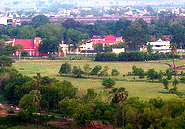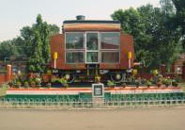Welcome to Jamalpur the world’s most beautiful place! Munger, Bihar
Welcome to Jamalpur ||Munger, BiharArchive for July, 2011
Jamalpur workshop to build diesel locos
Jamalpur, Bihar:- The Jamalpur workshop of Indian Railways has bagged orders from Rail India Technology and Economic Services (RITES) to manufacture diesel locomotives. It would manufacture locomotives after a lapse of 88 years.
These locomotives will be of WDS6 type. The workshop would initially manufacture three such locomotives at an estimated cost of Rs 2.33 crore, said chief works manager (CWM), Jamalpur workshop, Animesh Sinha. According to him, the workshop would get a boost with the RITES orders. It is rich in technical expertise and has all the modern facilities available at any workshop of railways across the country, he said.
Sinha told TOI that the Jamalpur workshop has become the only workshop in the country capable of manufacturing all four types of rolling stocks for railways namely diesel locomotives, cranes, tower cars and goods wagons of different types, including BOX-NHL, BLC and BVZI. Besides, it is the main hub of repair centre of locomotives, cranes, tower cars and other equipments for railways, he said adding periodical overhauling of rolling stock has been the mainstay of the workshop.
Bihar School of Yoga
Bihar School of Yoga (BSY) was established in 1964 as the headquarters of International Yoga Fellowship. It aims to impart yogic training to householders and sannyasins alike. Since the first Yoga Teacher Training Courses which was held in 1968, the school has grown into a reputable International Training center of great renown.
The yoga School is situated at Ganga Darshan, which is built over a large hill overlooking the Utter vahini Ganga. Here, amidst an atmosphere of natural beauty, surrounding by scenic gardens,, green paddy fields and a majestic 180 degree panoramic sweep of the river Ganga, a new vision of yogic life is inspired.
The techniques of integral Yoga taught here are a synthesis of all approaches to personal development. Yoga Teachers Training, Yoga Health Management, Individual Sadhana, Hriya Yoga, Mantra Meditation and other advance courses are conducted by trained sannyasins on a group or individual basis for day and life residential students.
The Bihar School of Yoga has always been known for its excellent sannyasa training and was one of the first institutions to initiate and train female and overseas sannyasins on a large scale.
The institution houses a well-stocked Yoga Research Library with a large collection of books and data where most of the school’s publication of Yoga, health techniques and research are compiled. Ashram graphics, the modern printing press, prints all the BSY publications. It has a wide range of equipment’s and is staffed and managed by the sannyasins and disciples of the ashram who do everything from typesetting to dispatch.
Conventions, tours, seminars, workshops and lectures help spread the yogic message “from door to door and from shore to shore”. In addition to these, trained sannyasins are ever ready to conduct organized conventions, seminars and lecture tours throughout all the India and the world. This provides a solutions for the Yoga minded people who find it impossible to undertake a journey to Munger or any of the branch ashrams.
Japanese impressed by Bihar’s Super 30
A free coaching centre, Super 30, which helps children of labourers, tea stall owners and peons in Bihar reach the prestigious IIT engineering institutes, has impressed people in Japan too, its founder Anand Kumar says.
He says that in the last few years, Super 30 has became quite popular in Japan after several newspapers, magazines and TV channels covered his inspiring life story and the impact of his ‘Super 30′ school, which has so far helped 236 students from underprivileged families clear the highly competitive IIT-JEE, drawing worldwide attention.
“All the eyes of Super 30 students shine with hope, while the eyes of Japanese children look exhausted due to computer games,” said a Japanese in his response to a documentary on Super 30, which was shown on Japan’s popular TV Channel NHK channel.
Another Japanese described the Super 30 as a “learning experience”. “We realized how crucial education is. We really have to learn from India how to survive in the 21st century,” he said after watching the documentary on Super 30.
These are from among responses of dozens of Japanese that were sent to Kumar from Emiko Amagawa, producer of NHK, Japan Broadcasting Corporation, to show the kind of praise his efforts have fetched in that country.
“Watching Super 30 students at the Ramanujan School of Mathematics make tremendous efforts to become engineers and contribute to the community and the country, I understand why India can and will grow dramatically,” another Japanese said in his response.
“We have been receiving phone calls and messages from the audience in Japan. They are very impressed by all that you are doing and the passion of your students,” Emiko Amagawa informed Kumar.
“The response of the Japanese after watching a documentary on Super 30 has encouraged me to work hard to provide more opportunity to talented poor students,” Kumar told IANS.
He credited the success of Super 30 mainly to his dedicated team of teachers and sincere bunch of students, who toil to achieve their goal. “I am happy with the recognition Super 30 has got. It was started to help talented students from poor families, who would otherwise find it difficult even to continue studies. Such recognition will give me strength to continue,” he added.
Two weeks ago, the journalists of NHK came up with a book, “Indo No Shougeki”, published by Japan’s well-known publisher Bhunshun. The book has a chapter exclusively on Kumar’s struggle and the success of his pioneering Super 30 initiative. Priced at 1,800 yen (RS.1,050), the book describes him as a ‘wind of change’, who is contributing to India’s rapid progress.
The book is quite popular among the students of the Japan Management School. “We had seen and read a lot about Super 30 through TV programmes and newspapers. It is amazing and shows how and why India is progressing fast. The answer lies in education and the passion for it,” said Takyuki Doi, a student from Tokyo, who visited Super 30 a few days ago.
The book revolves round India’s development story. It says that education is at the root of India’s progress march and people like Anand Kumar are lending strength to it. It says how Kumar, who could not go to Cambridge for want to money, is helping several talented students from the underprivileged families reach out for higher education.
Former Miss Japan Norika Fujiwara came to Patna to make a film on Super 30 for Man Union. Japan’s leading newspaper Yomiuri also carried an exhaustive feature on Anand and his Super 30 School.
Kumar, who started the Ramanujan School of Mathematics in 1992, founded the Super 30 in 2002.
Most of the successful candidates have been from the underprivileged sections of society. They are provided with free food, lodging and free coaching.
The students have to pass a competitive test to get into Super 30 and then commit themselves to a year of 16-hour study each day, Kumar said.
Source: mangalorean.com
Railways set to modernize 150-yr-old Jamalpur workshop
The railways has chalked out an ambitious plan for modernization of the 150-year-old railway workshop at Jamalpur in Munger district at an estimated cost of Rs 117.46 crore.
Under the new plan, the railways would further improve its infrastructure to cope with the demands of new technology to manufacture rail components as well as to carry out maintenance work of locomotives, cranes and wagons smoothly.
According to chief works manager (CWM) Animesh Sinha, the Jamalpur workshop had come into being on February 8, 1862. It was the first workshop of the country to manufacture steam engine CA 764 `Lady Curzon’ in 1899 at a cost of Rs 33,000 only. Besides, it was the first to establish a rail foundry in 1893 whereas it had set up a rolling mill in 1870 to fulfill the needs of the railways, he said.
Source: TOI


















